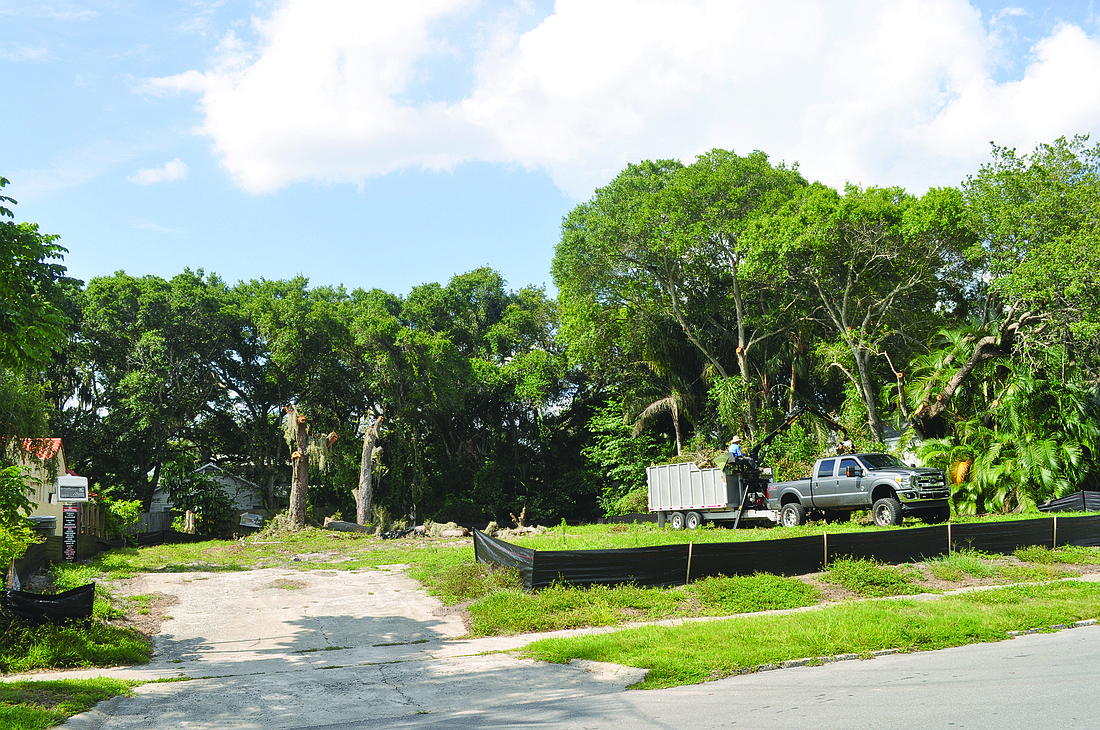- April 27, 2024
-
-
Loading

Loading

Rob Patten is pretty familiar with landscape design, architecture and environmental preservation, and he’s got a major problem with what’s happening to the trees in his neighborhood, Hudson Bayou.
“There’s a disturbing and rapid trend,” Patten said. “What’s happening is stately oaks and other trees are removed indiscriminately, I would say, when older houses are sold and the houses are removed to build much larger houses.”
Patten, who is a partner with the landscape architecture firm AquaTerra and formerly served as the Sarasota County director of environmental services, is also the president of the Hudson Bayou Neighborhood Association. At a neighborhood meeting May 16, residents in the area met and agreed the phenomenon of disappearing trees at construction sites is becoming a worrisome issue.
“Residents offered to form a committee, to do the research and present the information with the city, to meet with the builders,” Patten said. “It struck a real cord.”
Tree issues aren’t unique to Hudson Bayou. In October, residents of Arlington Park discussed the same problem on vacant lots in their neighborhood, attempting to brainstorm a solution. At meetings of the Coalition of City Neighborhood Associations this year, representatives for multiple areas of the city have expressed concern about the well-being of their trees, raising the possibility of working together to solve the ongoing problem.
Based on this growing anxiety, it’s clear the presence of these trees — large oaks that are decades old or clusters that create a natural canopy above the entire neighborhood — are critical elements of the fabric of several city neighborhoods. It’s an element residents won’t let go of without a fight.
Patten and other Hudson Bayou residents aren’t just interested in shining a light on the problem, however. They’re determined to legitimately find a solution to prevent more trees from leaving their neighborhood, focusing on three factors they believe are heavily contributing to the current environment.
The first problem, Patten said, is that builders view trees as a hassle without looking at the big picture. If residents can establish a dialog with the builders in the neighborhood, he hopes he can extol the virtue of planning around the trees, instead of paving over them to build the largest house possible.
“(Trees) can add thousands of dollars of value, and yet some builders feel it’s costing them money because it’ll take them two more days to preserve it,” Patten said. “It’s kind of short-sighted.”
That leads to his second prong: Not only are houses being built bigger as the economy recovers; they often ape a retro style. As a result, Patten said, landscape architects are using a retro model of thinking when constructing ’50s- and ’60s-style homes, one that doesn’t prioritize preservation. He called on those architects to lead the charge when builders come to them with a new parcel.
“Rather than just planting three or four tall royal palms, I think they need to set the trends and modernize the approach for building these houses,” Patten said.
Finally, Patten arrives at a point that many other neighborhoods have raised before him. He believes the city’s tree protection ordinance needs to become more stringent.
Although the Urban Design Studio is working on adding additional protections for trees, Patten said Hudson Bayou couldn’t afford to wait for those changes to be approved. Residents are looking at regulations in other municipalities for guidance before going to the city with their findings.
City staff was present to listen at this month’s Hudson Bayou Neighborhood Association meeting. City arborist Nigel Weait said the city was responsive to neighborhood concerns when they pop up, though he declined to comment on whether tree removal was a growing problem citywide.
Still, Patten doesn’t want to rely too heavily on government involvement. He is hopeful that by getting the ears of builders and designers, all parties could work toward a solution.
“I firmly believe, if you have meaningful dialog with the people who are part of the situation, you can get a lot done without bringing government regulations into it,” Patten said.
The newly formed Hudson Bayou tree taskforce is already setting out to talk to anyone and everyone that may be able to help cut down on the tree removal. If their efforts aren’t effective, Patten isn’t optimistic about the future impact on the city.
“We’re talking about oaks of 50 to 100 years old that are being cut down and replaced with 12-foot saplings,” Patten said. “That just doesn’t make sense. We’re destroying the goose that lays the golden egg by destroying the character of our neighborhood.”